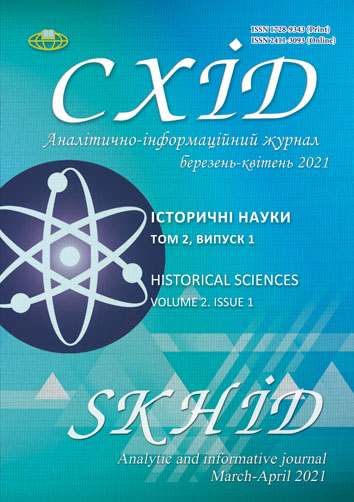“TERROR-FAMINE” AS A WAY TO BUILD OBEDIENT SOCIETY (ON THE EXAMPLE OF OLEVSK DISTRICT VILLAGES IN ZHYTOMYR REGION)
DOI:
https://doi.org/10.21847/1728-9343.2021.2(1).230337Keywords:
collectivization, grain procurement, in-kind fines, terror-famine, Holodomor, peasants, Olevsk districtAbstract
The article shows the implementation of the policy of subjection of the peasants of the border Olevsk district in Polissya by the Soviet authorities through the use of terror-famine. Based on the materials of the State Archives of Zhytomyr Region, which were first introduced into scientific circulation, and the involvement of the available source and historiographical array, it has been proved that the Holodomor was used as genocide in the villages of the district, as well as throughout Ukraine, and exterminated the population only in 1933. The concept of “famine” or “terror-famine” should be applied to mass deaths in 1932, a well-planned action by the authorities to exterminate the number of peasants who resisted the government’s policies and thus force everyone else to work on the collective farms with “full efficiency”. Having studied in detail the content of the materials of the Olevsk Party Committee and the reports of the 19th Olevsk Border Department, the author reconstructs the course of collective farm construction in the “Olevsk border area”, emphasizing that the resistance of the peasants was fierce. This provoked the authorities to use artificial famine against the dissatisfied in order to build ideal farms, demonstrative for foreign neighbors, on the border.
References
Bem, N. (2003). Stavlennia ukrainskoho selianstva do likvidatsii kurkulstva yak klasu ta sutsilnoi kolektyvizatsii silskoho hospodarstva (1930-1931 rr.). Retrieved from: http://history.org.ua/JournALL/pro/9/9.pdf (In Ukrainian)
Bokiy, N. (2003). Do istorii kolektyvizatsii na Pravoberezhnii Ukraini (suchasna Kirovohradshchyna). Retrieved from: http://ena.lp.edu.ua/bitstream/ntb/9658/1/11.pdf (In Ukrainian)
Chepik, V. (2010). Kolektyvizatsiia silskoho hospodarstva na Olevshchyni. Nezalezhna. – Independent. № 19, pp.1. (In Ukrainian)
Conquest, R. (2007). Zhnyva skorboty. Radianska kolektyvizatsiia i holodomor. Lutsk. (In Ukrainian).
Konventsiia pro zapobihannia zlochynu henotsydu ta pokarannia za noho. (1948). Retrieved from: https://zakon.rada.gov.ua/laws/show/995_155#Text (In Ukrainian).
Kulchytsky, S. (2004) Problema kolektyvizatsii silskoho hospodarstva v stalinskii «revoliutsii zverkhu». Retrieved from: http://history.org.ua/JournALL/pro/12/2.pdf (In Ukrainian)
Kulchytsky, S. (2007). Holodomor 1932–1933 rr. yak henotsyd: trudnoshchi usvidomlennia. Kyiv. (in Ukrainian).
Kulchytsky, S. (2018). Substantiation of the Holodomor of 1932–1933 as genocide in the light of the concepts of R. Conquest and R. Lemkin. Ukrainian Historical Journal. 4: 98-126. Retrieved from: http://resource.history.org.ua/publ/ UIJ _2018_4_8 (In Ukrainian)
Lemkin, R. (1944). Axis Rule in Occupied Europe: Laws of Occupation, Analysis of Government, Proposals for Redress. Foundations of the Laws of War 2nd Edition.
Makhorin, H. (2017). Ukrainska natsionalna revoliutsiia 1917-1922 rr. ta yii perebih na Zhytomyrshchyni. Zhytomyr, 209 p. (In Ukrainian)
Marochko, V. (2014). Terytoriia Holodomoru 1932-1933 rr. Kyiv, 64 p. (In Ukrainian)
Natsionalna knyha pamiati zhertv Holodomoru 1932-1933 rokiv v Ukraini. (2008). Zhytomyr: «Polissia», 1116 pp. (In Ukrainian)
Nove, A. (1986 November, 3). When the Head Is Off… The Harvest of Sorrow: Soviet Collectivization and the Terror-Famine by Robert Conquest. The New Republic.
Pylypchuk, M. (2012). Drevlianski perlyny. Pid pokrovom Presviatoi Bohorodytsi. Zhytomyr, 156 pp. (In Ukrainian)
Serbyn, R. (2009). Rafael Lemkin. Radianskyi henotsyd v Ukraini (stattia 28 movamy). Kyiv, 208 рр. (In Ukrainian).
Zhnyva skorboty: 1932-1933 roky u spohadakh meshkantsiv Olevskoho raionu.(2010). Korosten, 90 рр. (In Ukrainian)
Downloads
Published
How to Cite
Issue
Section
License
Copyright (c) 2021 Наталія Курильчук

This work is licensed under a Creative Commons Attribution-NonCommercial-NoDerivatives 4.0 International License.
1. Authors bear responsibility for the accuracy of facts, quotations, numbers and names used.
2. Manuscripts are not sent back.
3. The publisher does not always agree with the authors' opinion.
4. The authors reserve the right to authorship of the work and pass the first publication right of this work to the journal under the terms of a Creative Commons Attribution Non-Commercial License, which allows others to freely distribute the published research with the obligatory reference to the authors of the original work and the first publication of the work in this journal.
5. The authors have the right to conclude separate supplement agreements that relate to non-exclusive work distribution in the form in which it has been published by the journal (for example, to upload the work to the online storage of the journal or publish it as part of a monograph), provided that the reference to the first publication of the work in this journal is included.

